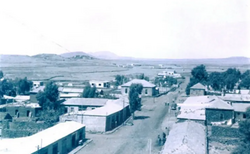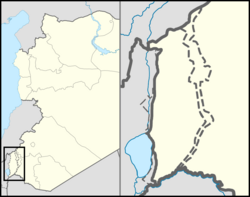Khushniyeh (Arabic: الخشنية) is a former Syrian town located in the Golan Heights.[3]
Khushniyeh
الخشنية | |
|---|---|
 View of Khushniyah before its destruction in 1967 | |
| Coordinates: 32°59′56″N 35°48′40″E / 32.99889°N 35.81111°E | |
| Country | |
| Syrian Governorate | Quneitra Governorate |
| Syrian District | Quneitra District |
| Syrian Subdistrict | al-Khisniyah |
| Destroyed | June 10, 1967 |
| Population (1967) | |
| • Total | 1,029[1][2] |
History
editArcheological excavations have revealed remains from the Roman, Byzantine and Islamic periods.[4]
The German-American archaeologist Gottlieb Schumacher surveyed the village in the 1880s and described it as: "El-Khushniyeh —A large winter village on the Roman street west of er-Rafid, with scattered building stones. Most of the huts have fallen to pieces."[5]
The old part of town was built with basalt stones.[4] The residents worked with livestock and agriculture and Khushniyah was known for its vineyards and figs.[4] Eucalyptus trees was planted in the town to fight of malaria.[4] There was also several schools, a police station and a mosque built in 1956.[4]
After Israel occupied the area in the Six-Day War, they began destroying Syrian villages in the Golan Heights.[6][7] Khushniyeh was destroyed in 1967.[1] The population before the war was 1029.[1]
Khushniyeh after destruction
editReferences
edit- ^ a b c "al-Marsad" (PDF). p. 4. Retrieved 2024-08-31.
- ^ Kipnis, Yigal (2013). The Golan Heights: Political History, Settlement and Geography since 1949. London and New York: Routledge. p. 245. ISBN 978-1-136-74092-3.
- ^ "Golan Heights and vicinity : October 1994". The Library of Congress. 1994-01-01. Retrieved 2024-08-31. (Al Khushniyah shown as an abandoned/dismantled Syrian village)
- ^ a b c d e "بلدة الخشنية". General Organization of Radio and TV - Syria (in Arabic). 2022-09-27. Retrieved 2024-09-04.
- ^ Schumacher, Gottlieb (1888). The Jaulân: Surveyed for the German Society for the Exploration of the Holy Land. London: Richard Bentley and Son. p. 194. Retrieved 2024-09-01.
- ^ Shai (2006). "The Fate of Abandoned Arab Villages in Israel, 1965-1969". History and Memory. 18 (2): 100–101. doi:10.2979/his.2006.18.2.86.
- ^ Sulimani & Kletter 2022, pp. 55–56
Bibliography
edit- Sulimani, Gideon; Kletter, Raz (2022). "Settler-Colonialism and the Diary of an Israeli Settler in the Golan Heights: The Notebooks of Izhaki Gal". Journal of Holy Land and Palestine Studies. 21 (1). Edinburgh University Press: 48–71. doi:10.3366/hlps.2022.0283. ISSN 2054-1988.
